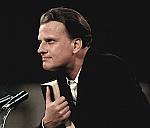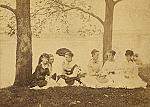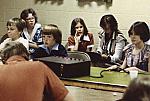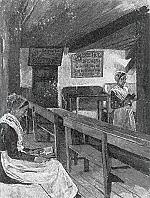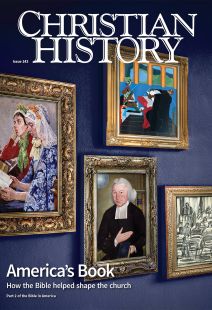Giving sinners no rest
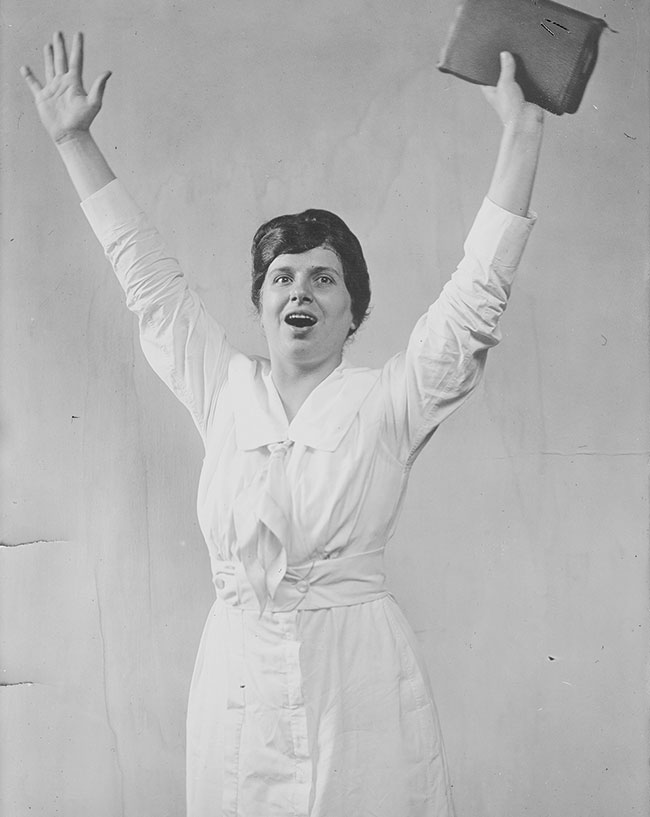
[Aimee McPherson, c. 1920—Bain News Service, publisher / [Public domain] Wikimedia]
If a Man have Money, he may purchase Land or Cattle or Corn, but he cannot purchase Pardon, but the blood of Christ will procure the Pardon of Sin. Eph. 1.7. In whom we have Redemption through his blood, the forgiveness of sins. Rev. 5.9. Thou hast Redeemed us to God by thy blood.
Before Jonathan Edwards (1703–1758) played his part in the Great Awakening, a popular Puritan minister from Northampton, Massachusetts, sparked revival with these words. This pastor also happened to be Edwards’s grandfather. Solomon Stoddard (1643–1729), like most other colonial New England ministers, served in only one church—from 1669 until his death, a total of 60 years! Northampton, on the Connecticut River, was located on what was at the time the western frontier. Stoddard urged the need for spiritual awakening upon fellow ministers, but received only a lukewarm response. However, that did not stop him:
Men are in a Deep Sleep and flatter themselves as if there were no Hell, or at least that God will not deal so harshly with them as to Damn them. Psalm 36:2. Ministers must give them no Rest in such a Condition. They must pull them as Brands out of the Burnings [Zec 3:2].
Stoddard followed his own advice completely. In response Northampton experienced five awakenings during his six decades as pastor. He set a template for evangelistic preaching in the American tradition— focused on moving sinners toward conversion through vivid application of the biblical text.
An angry God?
When Stoddard died in 1729 at 86 years, Edwards, who had been his assistant for two years, became pastor. His congregation could not have guessed that one day their tall, mild new minister would be called one of the best minds America has ever produced. In 1734 Edwards began to stress evangelism from his Northampton pulpit. Other pastors promoted the awakening, and it spread through western Massachusetts and Connecticut.
Edwards began traveling outside his parish to preach and in 1741 delivered his famous sermon “Sinners in the Hands of an Angry God” in Enfield. It was this sermon that marked Edwards as a hell-fire and brimstone preacher; however, though Edwards wrote over 1,000 sermons, less than a dozen carried this tone.
Rather than gleefully picturing the doom of sinners, Edwards would shudder to think that any of his hearers might not heed his warnings about eternal damnation:
The wrath of Almighty God is now undoubtedly hanging over a great part of this congregation. Let every one fly out of Sodom: “Haste and escape for your lives, look not behind you, escape to the mountain, lest you be consumed.” [Genesis 19:17]
Edwards was by all accounts never a spellbinding speaker. All of his sermons were delivered in the same calm fashion—but with penetrating force.
Among those spreading revival was George Whitefield (1714–1770), who made his second visit to the colonies in 1740–1741. Whitefield would make five more voyages to America, preaching extensively, biblically, and dramatically wherever he went (for an excerpt, see p. 14). His famed “The Conversion of Zacchaeus” begins “Salvation, every where through the whole Scripture, is said to be the free gift of God, through Jesus Christ our Lord” and, after a verse-by-verse explanation of Luke 19, he concludes by urging his hearers:
Do not therefore any longer crucify the Lord of glory. Bring those rebels, your sins, which will not have him to reign over them, bring them out to him: though you cannot slay them yourselves, yet he will slay them for you.
Many have never heard
By 1800 nearly a million people had made their way west. In 1803 the crowning achievement of Thomas Jefferson’s first administration came: the Louisiana Purchase. It doubled the country’s area and gave an enormous new impulse to western migration. How, believers wondered, could the church possibly keep ahead of this vast movement? One Episcopal preacher wrote of the Carolinas:
How many thousands . . . never saw, much less read, or ever heard a Chapter of the Bible! How many Ten thousands who never were baptized or heard a Sermon!
Here the Second Great Awakening began with James McGready (1763–1817). A stirring preacher, McGready saw an extensive awakening spread over north central North Carolina. McGready spoke of heaven and its glories, thundered about hell and its torments, and questioned his hearers about their salvation: “God declares that we must be converted, or be forever damned; that we must be born again, or never enter the kingdom of Heaven” [John 3:3].
McGready’s revival in late July 1800 at the Gasper River—as many as 8,000 may have shown up—was the first true camp meeting. Barton W. Stone (1772–1844), a Presbyterian pastor near Lexington, Kentucky, traveled to Logan County to observe McGready’s work and returned home to plan a similar meeting for 1801 at Cane Ridge (for more on Stone, see CH 106).
Better publicized than McGready’s meeting, Cane Ridge attracted between 10,000 and 25,000 participants. (Lexington, then the largest town in Kentucky, had fewer than 1,800 citizens!) It delighted Stone that Presbyterians, Methodists, and Baptists were united around the biblical message: “The salvation of sinners was the one object. We all engaged in singing the same songs, all united in prayer, all preached the same things.” Indeed, camp meetings would often have multiple preaching stations operating concurrently.
The work of McGready, Stone, and others increasingly emphasized that God invites people to cooperate with him by praying and preaching for revival. The stage was set for a shift, not in message, but in methods. Onto that stage stepped Charles G. Finney (1792–1875).
Finney was tall and handsome, with eyes one observer described as “large and blue, at times mild as an April sky, and at others, cold and penetrating as polished steel.” He possessed a majestic voice immensely persuasive with crowds. In addition he had studied to be an attorney, and he turned his courtroom skills to the use of the pulpit.
As he plunged into evangelistic work in the back-woods of upper New York State in 1824, he offended some who said he destroyed the dignity of the pulpit with his direct, personal style. But Finney’s preaching had a rapid-fire impact.
When Finney opened evangelistic meetings in upstate New York in 1825, he began seven years of the most intense evangelistic activity that the United States has seen. The revival spread all over the region (called the “burned-over district”) and the nation. As Finney’s fame grew, critics arose to condemn some of his innovative practices. Yet for everyone who found fault, Finney had supporters who praised his aggressive evangelism, as he described it in Lectures on Revivals of Religion:
If when a sinner is under conviction, you pour in the truth, put in the probe, break up the old foundations, and sweep away his refuges of lies, and use the Word of God, like fire and like a hammer, you will find that they will come out with clear views, and strong faith, and firm principles, not doubting, halting, irresolute Christians, but such as follow the Lord wholly.
Praying and preaching
Other nineteenth-century revivals might seem an exception to this line of dramatic sermons, as they arose at first from lay prayer meetings. Weekly meetings by Sarah Worrall Lankford (1806–1896) and Phoebe Worrall Palmer (1807–1874) launched the Holiness movement in the late 1830s. Later, during the 1857 financial panic, Jeremiah Lanphier (1809–1898) inspired 10,000 people to gather daily for prayer throughout New York and eventually all over the nation in what was called the “Businessmen’s Revival.”
Yet this focus on prayer was paired with an emphasis on revivalist preaching leaning heavily on Scripture to explain the demands of the gospel and ask for a decision. Palmer and her husband, Walter, traveled and preached through the United States, Canada, and the United Kingdom, with remarkable response—as did their Holiness colleague Amanda Berry Smith (1837–1915), the country’s most famous Black evangelist. While we have few records of Palmer’s or Berry’s sermons, their writings frequently reference and apply biblical tests, as in Palmer’s The Way of Holiness:
As the Lamb slain from the foundation of the world [Revelation 13:8], Christ laid himself upon the altar; “tasted death for every man” [Hebrews 2:9], and “bore the sins of the whole world in his own body.” [1 Peter 2:24]
Educator, Bible teacher, and minister D. L. Moody (1837–1899, see pp. 36–39), also specialized in vivid preaching with frequent biblical references. Moody reminded his hearers, “If you will read your Bible in light of Calvary, you will find there is no other way of coming to heaven but by the blood.”
In the twentieth century, preachers as diverse as these passed the mantle of revival to new generations—including ex-baseball player Billy Sunday (1862–1935), Foursquare Church founder Aimee Semple McPherson (1890–1944), and the man many called “America’s pastor”—Billy Graham (1918–2018; see CH 111).
They spoke in huge auditoriums and eventually to radio and television audiences; by the time Graham died, his sermons were viewed on the internet. Yet they would have recognized the biblically framed mission Stoddard had put forth almost 400 years previous: “Ministers must give [sinners] no Rest in such a Condition. They must pull them as Brands out of the Burnings.”
CH
By Keith J. Hardman and Jennifer Woodruff Tait
[Christian History originally published this article in Christian History Issue #143 in 2022]
Keith J. Hardman (1931–2017) was professor of religion and philosophy at Ursinus College and author of Seasons of Refreshing and The Spiritual Awakeners. This article is adapted from CH #23—he wrote the entire issue. Jennifer Woodruff Tait is managing editor of Christian History.Next articles
Support us
Christian History Institute (CHI) is a non-profit Pennsylvania corporation founded in 1982. Your donations support the continuation of this ministry
Donate



